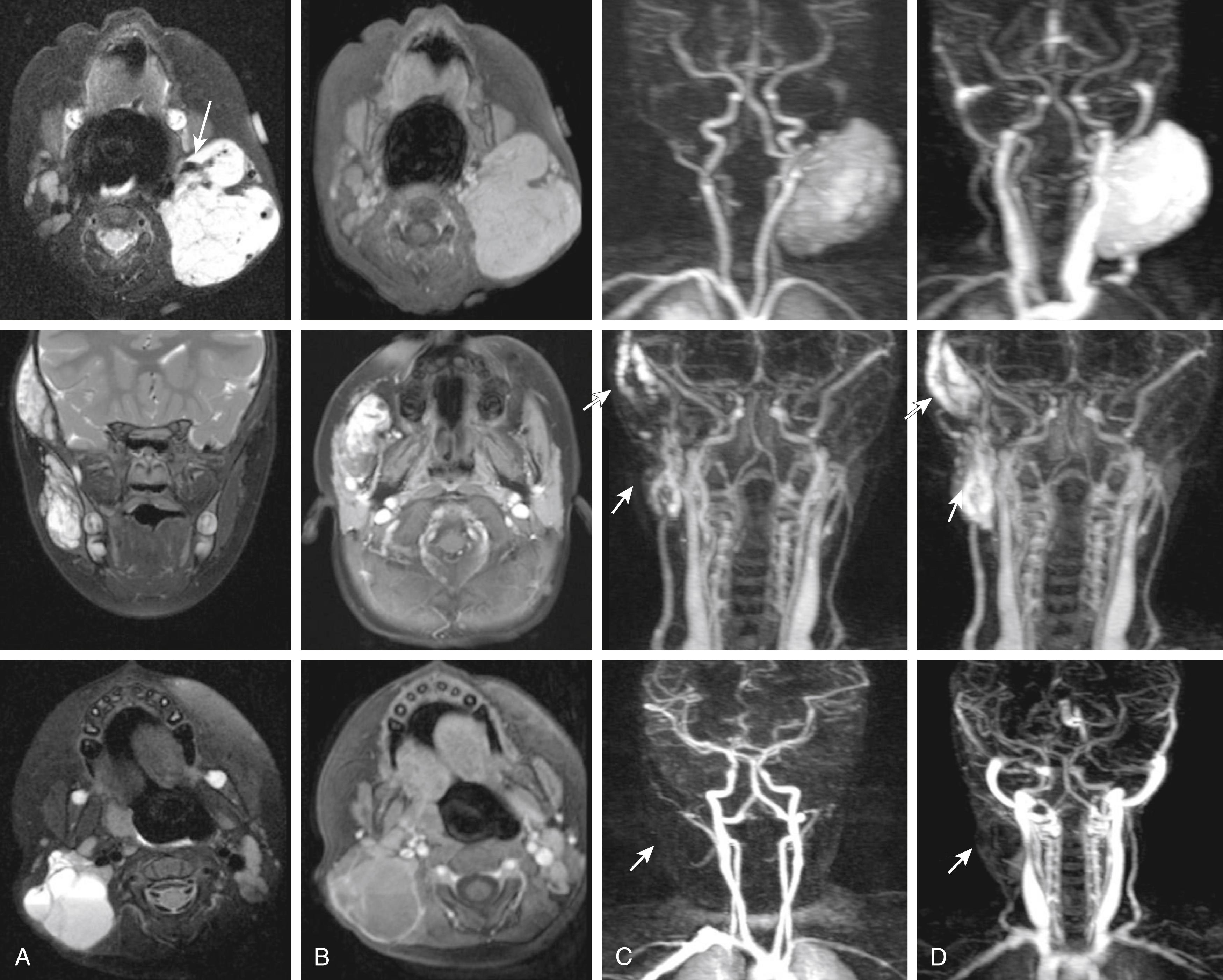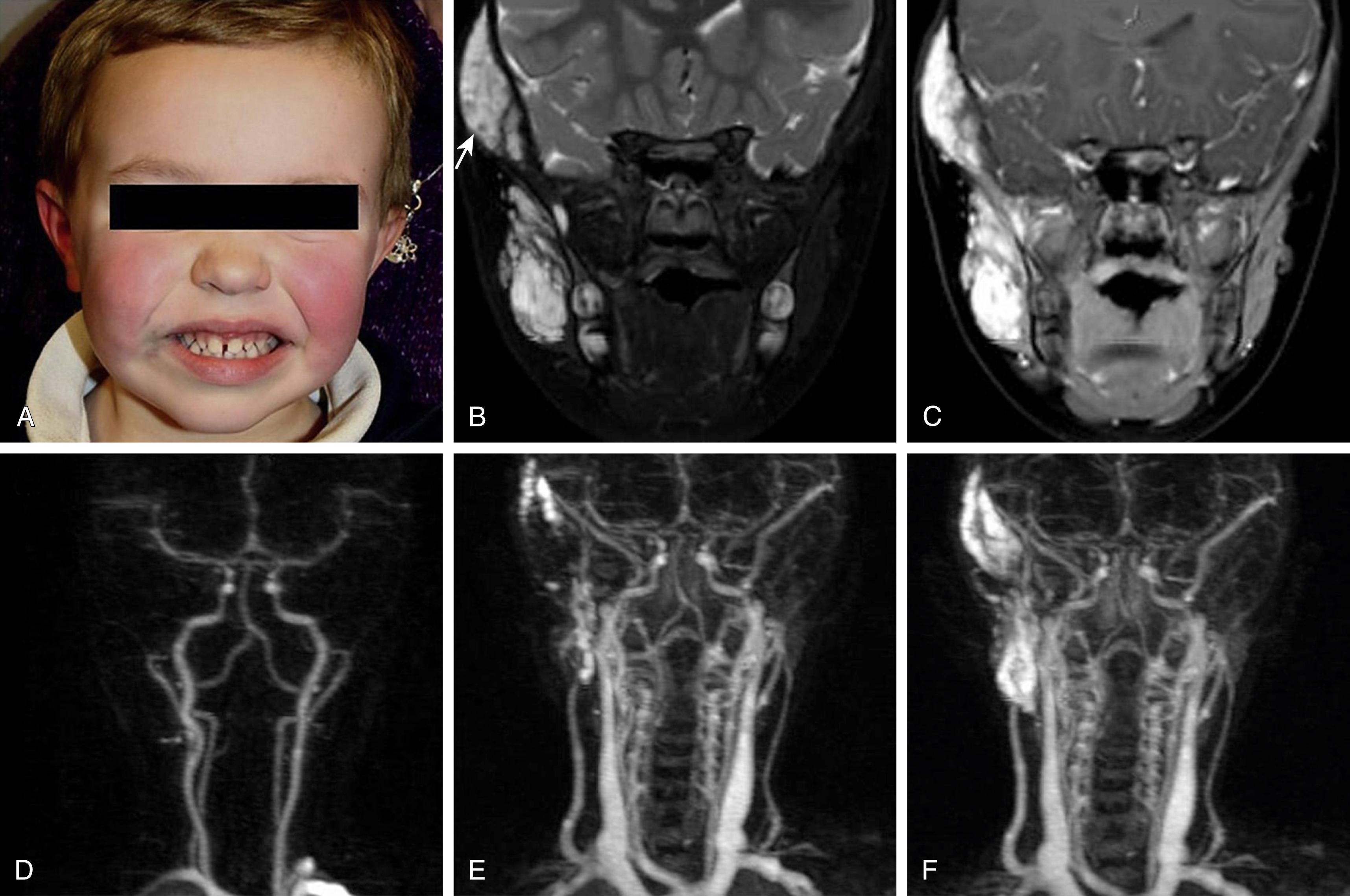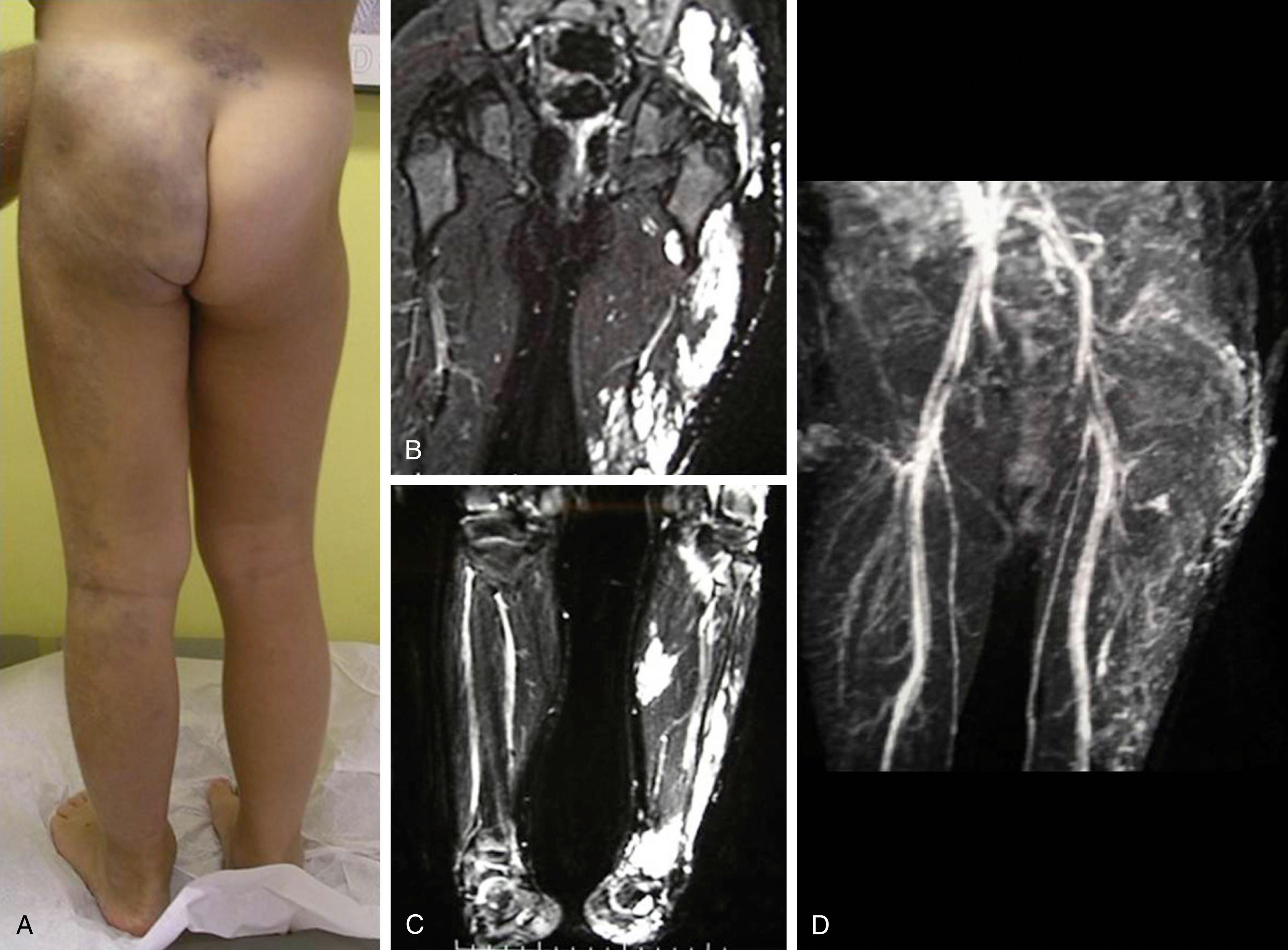Physical Address
304 North Cardinal St.
Dorchester Center, MA 02124
Vascular anomalies comprise a collection of disorders characterized by abnormal, non-neoplastic blood vessel growth. The need for accurate characterization of these lesions has led to the development of a classification system based on biologic behavior which is approved by the International Society for the Study of Vascular Anomalies (ISSVA). , This classification system was most recently updated in 2018. It broadly divides vascular anomalies into vascular malformations and vascular tumors ( Table 172.1 ).
| Vascular Anomalies | ||||
|---|---|---|---|---|
| Vascular Tumors | Vascular Malformations | |||
| Simple | Combined | Of Major Named Vessels | Associated with Other Anomalies | |
|
|
|
|
|
Vascular malformations are the more common anomaly, comprising approximately two-thirds of all vascular anomalies; they are congenital, non-neoplastic lesions that develop secondary to defects in different molecular pathways of vasculoneogenesis. , Vascular malformations are further subdivided into low- and high-flow lesions based on their hemodynamic characteristics. Low-flow vascular malformations are composed of capillaries (capillary malformation), veins (venous malformation), lymphatics (lymphatic malformation [LM]), or a combination (venolymphatic malformation). High-flow vascular malformations are characterized by a direct communication between arterial and venous vessels without an intervening capillary bed (arteriovenous malformations [AVMs] and arteriovenous fistulas [AVFs]).
Vascular tumors are neoplastic vascular anomalies defined by the presence of abnormal endothelial proliferation. Overall, the most common vascular tumor is the infantile hemangioma, which is benign and characteristically involutes over time. Angiosarcoma and epithelioid hemangioendothelioma are examples of malignant vascular tumors and require oncologic evaluation and treatment.
This chapter focuses on the diagnosis and treatment of vascular anomalies most commonly treated by endovascular specialists.
The diagnosis of vascular malformations can be confusing due to their relative rarity and overlapping clinical and imaging features. Because of this confusion, suspected vascular malformations are often referred to centers with a dedicated multidisciplinary vascular anomaly team for diagnostic workup and treatment. It is common to seek multidisciplinary consultation from dermatology, plastic surgery, neurosurgery, vascular surgery, and diagnostic and interventional radiology. At our institution, the vascular anomaly team classifies vascular malformations according to an established visual pathway, known as the S.E. Mitchell vascular anomalies flowchart (SEMVAFC), which combines clinical and imaging findings to accurately identify lesions. In some cases, syndromes associated with vascular malformations, such as Parkes–Weber syndrome and Klippel–Trénaunay syndrome (KTS), can be identified with SEMVAFC.
Vascular malformations can be imaged with duplex ultrasonography (US), computed tomography (CT), magnetic resonance imaging (MRI), and conventional angiography. Patients are often first evaluated with US, which has the advantages of wide availability, lack of ionizing radiation, patient comfort, and real-time hemodynamic characterization. However, US is limited by a small field of view that may exclude portions of large or deep vascular malformations. MRI is the preferred examination for most lesions, given its wide field of view, excellent soft tissue resolution, and ability to assess enhancement characteristics ( Fig. 172.1 ). Accurate classification is assisted by the addition of dynamic contrast-enhanced magnetic resonance angiography (DCE-MRA), which produces imaging of the lesion in the arterial, capillary, venous, and delayed venous phases. MRI is also useful after treatment to judge changes in size and flow characteristics.

At our institution, the MRI protocol for vascular anomalies includes multiplanar fat-saturated T2-weighted, T1-weighted, and fat-saturated precontrast and postcontrast T1-weighted sequences ( Fig. 172.2 ). MRA is an integral component of the postcontrast portion of the examination and is typically performed with contrast-enhanced time-resolved angiography with interleaved stochastic trajectories (TWIST) sequence. The typical MRI appearance of common vascular anomalies is reviewed in Table 172.2 and discussed in detail in the following sections.

| IH | VM | LM | AVM | AVF | |
|---|---|---|---|---|---|
| Solid mass | Yes | No | No | No | No |
| Phlebolith | No | Yes | No | No | No |
| Enhancement | Avid, homogenous | Variable | None (cyst periphery) | Avid, serpiginous | Avid, serpiginous |
| DCE-MRA | Arterial | Venous | None | Arterial with early venous drainage | Arterial with early venous drainage |
The two most common low-flow vascular malformations encountered in clinical practice are venous malformations (VMs) and LMs.
VMs are uni- or multilocular lesions composed of postcapillary, endothelium-lined venous channels with abnormal mural smooth muscle. Most VMs occur sporadically; however, 1% to 2% may be inherited as an autosomal dominant trait. Glomuvenous malformation (GVM), cutaneomucosal venous malformation (CMVM), cerebral cavernous VM, and blue rubber bleb nevus syndrome (BRBNS) are examples of hereditary diseases that can result in multiple lesions. , VMs range from small solitary lesions localized to the skin and subcutaneous tissues to diffuse masses that extend across multiple tissue planes and encase vascular, nervous, and visceral structures. VMs most commonly arise in the head and neck but can also affect the trunk and extremities. On physical examination, superficial VMs appear as compressible, bluish, nonpulsatile masses ( Figs. 172.3 and 172.4 ). Lesions can expand with increased local venous pressure, and may result from dependency or with a Valsalva maneuver. Calcified phleboliths are characteristic and may be found via palpation or imaging. Common complications of VMs include pain and swelling related to phlebothromboses, infection, and psychosocial issues related to disfigurement. Additional morbidities are related to the specific location of the VM. For example, lesions in the head and neck may compromise respiration, speech, deglutition, and vision. VMs in the extremities can cause gait instability and limit mobility. Lesions within the gastrointestinal and genitourinary tracts can cause intraluminal hemorrhage resulting in acute and chronic anemia.


LMs are benign unilocular or multilocular cystic lesions composed of dysplastic endothelium-lined lymphatic channels. Cysts vary in size and may be classified as macrocystic (individual cysts >1–2 cm), microcystic, or mixed. The majority of lesions are sporadic, although some lesions are associated with Turner and Noonan syndromes. , Similar to other vascular malformations, LMs are usually diagnosed at birth or during the first few years of life, but they may occasionally present later, in childhood, adolescence, or adulthood. The majority of LMs occur in the head and neck, but lesions are also found in the chest, axillae, and perineum. On physical examination, macrocystic LMs in the superficial soft tissues are palpable as cystic, rubbery, or ballotable masses ( Fig. 172.5 ). Cutaneous LMs appear as small vesicles that discharge clear or milky lymphatic fluid when ruptured. A microcystic LM may simply appear as an area of soft tissue overgrowth. Intralesional hemorrhage is a common complication and typically results in pain and swelling. LMs may also enlarge and become painful in the presence of systemic infections. Like other vascular malformations, LMs in the head and neck can cause airway compromise. Lesions deep in the chest and abdomen can cause pleural, pericardial, and peritoneal chylous effusions.

Both VMs and LMs appear isointense to skeletal muscle on T1-weighted imaging and hyperintense on T2-weighted imaging, although intralesional hemorrhage will result in variable T1 and T2 signals depending on the age of blood products ( Figs. 172.3–172.5 ). VMs and macrocystic LMs are cystic in appearance, whereas microcystic LMs appear as solid masses. VMs will characteristically demonstrate foci of signal void, corresponding to phleboliths, and will enhance during the venous phase of dynamic MRA. The cystic channels of LMs do not contain phleboliths or enhance internally during MRA, but the channels may contain fluid levels related to prior hemorrhage, and the peripheries of the cysts can enhance. Duplex ultrasound is useful to diagnose vascular malformations in the prenatal setting, to differentiate high- and low-flow lesions, and to monitor for complications such as thrombosis and hemorrhage. Sonographically, vascular malformations appear as hypoechoic or anechoic fluid- or debris-filled cystic lesions. Phleboliths in VMs will appear as hyperechoic foci with posterior acoustic shadowing. Low-flow lesions typically exhibit essentially no flow on Doppler analysis.
Low-flow vascular malformations typically grow and become more symptomatic over time. Treatment is often indicated to ameliorate pain, functional impairment, or disfigurement. Therapeutic options range from palliative to surgical measures. Compression garments can be used to decrease blood stagnation and swelling associated with vascular malformations in the extremities. Pharmacotherapy with aspirin and low-molecular-weight heparin (LMWH) may decrease the risk of thrombotic complications. However, these measures do not decrease the overall disease burden, and more invasive therapies are usually indicated. Among the various minimally invasive and surgical options, percutaneous sclerotherapy has emerged as the first-line treatment. , ,
Sclerotherapy involves percutaneous placement of needles into the cystic spaces of a vascular malformation under US and fluoroscopy. Cystic spaces are then filled with an endothelium-damaging agent, or sclerosant. The goal of this therapy is to cause fibrosis and eventual contraction of the vascular malformation. This technique has been shown to be safe and effective for treating low-flow vascular malformations throughout the body. ,
Patients who are being considered for sclerotherapy should ideally first be assessed in the clinic setting. A careful history and physical examination should be performed. A preintervention MRI should be obtained and reviewed with the primary goals of defining the extent of treatable (non-thrombosed) disease and identifying critical nearby structures that could be damaged during sclerotherapy. Details of the treatment approach, risks, benefits, postoperative expectations, and length of treatment should be clearly discussed with the patient.
VMs continuously undergo cycles of spontaneous thrombosis and thrombolysis in a phenomenon called localized intravascular coagulopathy (LIC). Although anticoagulants and platelet inhibitory medications are not typically withheld prior to the procedure, LIC is common with large VMs, causing elevation of d-dimer, hypofibrinogenemia, and thrombocytopenia. Immediately after sclerotherapy, LIC can progress to disseminated intravascular coagulopathy (DIC), and basic coagulation parameters (complete blood count, prothrombin time/international normalized ratio, partial thromboplastin time, fibrinogen, and d-dimer measurements) should therefore be obtained prior to interventions for large VMs. Patients with signs of LIC are prescribed LMWH for 10 days before and 10 days after the procedure. This therapy corrects the coagulopathy by halting the abnormal consumption of fibrinogen.
Patient comfort and immobility are important considerations during sclerotherapy; treatments are therefore generally performed in conjunction with general anesthesia. Patients who have cardiac, pulmonary, or other diseases that increase their risk for perioperative morbidity or mortality due to anesthesia should be identified and thoroughly evaluated by an anesthesiologist prior to undergoing sclerotherapy.
Sclerotherapy is best performed in an angiography suite. The patient should be positioned on the angiography table such that the area of interest can be safely and easily accessed by the operator. A preliminary US can be performed to identify the optimal skin entry sites, which are then prepped in sterile fashion. The procedure is considered “clean,” and antibiotic prophylaxis is recommended. Typical agents include intravenous cefazolin, and, for the penicillin-allergic patient, clindamycin.
Once preparations are complete and the patient is adequately sedated, US is used to guide a 21- or 22-gauge needle into the vascular malformation ( Fig. 172.5 ). Several needles can be placed during a single procedure to treat multiple noncommunicating components of a lesion concurrently. In the case of a VM, intralesional placement of a needle is confirmed with blood return upon aspiration and digital subtraction angiography (DSA). DSA is used both to estimate the capacity of the lesion and to determine the presence of rapidly draining veins, which, if present, must be closed via manual pressure or coil or glue embolization to allow adequate sclerosant dwell time. A negative-contrast-technique sclerosant is hand-injected into the vascular spaces under fluoroscopic guidance. Commonly used sclerosants for the treatment of VMs include ethanol, sodium tetradecyl sulfate (often foamed), ethanolamine oleate, and more recently bleomycin. Ethanol causes an inflammatory response that results in thrombosis and fibrosis and it typically has the lowest rate of recurrence after treatment. STS also causes an inflammatory response similar to ethanol that results in thrombosis and fibrosis. STS can also be administered as a foam (i.e. 1 cc STS 3%, 0.5 cc lipiodol, 4 cc of air) allowing for greater endothelial surface area coverage at a lower dose. Bleomycin is a chemotherapeutic agent that causes DNA damage leading to endothelial cell death. Since bleomycin does not induce significant thrombosis and inflammation, it is a safer agent to use in regions where compression of critical structures can occur from swelling (e.g., head and neck, orbit). Bleomycin does carry a risk of pulmonary fibrosis over a particular lifetime dose and can also cause permanent skin rashes in areas of inflammation. Adhesives should be avoided in patients being treated with bleomycin in order to avoid permanent skin hyperpigmentation.
The sclerosant is allowed to dwell within the lesion for a period of time, typically 15 to 20 minutes. Once the target dwell time is reached, the syringe is disconnected and the lesion assessed for venous return. If venous return is present, DSA is repeated to assess for residual disease and additional sclerosant is injected as needed. Once the treated area is closed and no venous return is noted, the needle is removed and the skin site is cleaned and dressed.
Sclerotherapy is also used for the treatment of macrocystic LMs. Needles are placed into the cystic spaces of the lesion, and lymphatic fluid is then completely aspirated and partially replaced with a sclerosant. In the case of larger macrocysts, placement of a drainage catheter and repeated infusions of sclerosant over several consecutive days may be necessary to close the cyst. Commonly used sclerosants for the treatment of LMs include doxycycline and bleomycin, although there are reports of using other agents such as ethanol, sodium tetradecyl sulfate, and OK-432 (Picibanil). , For microcystic LMs, bleomycin has been used with some success. Microcystic LMs refractory to sclerotherapy can be considered for surgical resection.
Patients should be monitored in a post-procedure care unit as they recover from anesthesia. Procedure-related inflammatory pain and swelling are expected, and pain management, icing, and elevation of the treated area are routinely implemented during the recovery period. Steroids are often given to control swelling, particularly when the treated lesion is in the head or neck or in an area susceptible to compartment syndrome, such as the forearm or leg. Most patients who undergo sclerotherapy are admitted for overnight observation and pain management.
Patients should be evaluated in the clinic 1 week following the procedure to assess for complications and again in 1 to 2 months after MRI has been performed to assess for reductions in symptoms and lesion size. Decreased T2 signal and enhancement are additional radiographic findings that are expected following sclerotherapy. Successful treatment is often incremental, and large multifocal lesions will likely require additional procedures. In many cases clinical results are seen long before imaging results appear significant. As the goal of therapy is to treat the patient’s symptoms, treatment can often be stopped despite little change on MRI.
The majority of complications are related to unintentional extravasation of sclerosant outside the lesion. Extravasation is of particular concern during the treatment of superficial VMs because it may result in irritation, blistering, and necrosis of the adjacent skin or mucosal surface. It is paramount that the fluoroscopic images and skin site be carefully examined during the injection phase of treatment in order to detect and minimize extravasation. Extravasation appears as a blush of contrast material outside the lumen of the lesion on fluoroscopy. Any instance of extravasation necessitates the immediate cessation of sclerosant injection. Skin necrosis is usually heralded by blanching, erythema, or other discoloration of the skin at the end of the procedure. Patients with suspected cutaneous complications should be examined frequently in the clinic and standard wound care, including topical antibiotics and clean dressings, should be practiced. Patients with areas of large or deep ulceration should be referred to a wound care specialist.
Hematuria, a consequence of sclerosant-induced hemolysis, is another common complication, particularly when large doses of sclerosant and intravenous contrast material are used. Placement of a urinary catheter is helpful to detect and monitor this complication, which tends to be a minor transient finding that resolves with oral and intravenous hydration.
Acute compartment syndrome is an uncommon complication that can arise when the treated lesion is located in a fascia-bound compartment, such as a muscular compartment in an extremity. Inflammatory swelling causes high intracompartmental pressures and insufficient blood supply to the muscles and nerves. Recognition of the intracompartmental location of a lesion is important for proper treatment planning, as the inflammatory response can be mitigated by the avoidance of excessive treatment. Post-procedurally, ice packs should be applied and tight circumferential dressings avoided. Steroid therapy (e.g., intravenous dexamethasone) can be considered for patients who do not respond to more conservative measures.
Patient-reported outcomes (PROs) have become an increasingly important metric when evaluating treatment outcomes after therapy of any type for vascular malformations. Outcomes reported by the patient are broad and can include somatic and psychosocial symptoms, functional limitations, and cosmetic concerns. This is of particular importance with low-flow malformations, which may not show significant changes on follow-up imaging despite clinical changes; thus, the patient’s report will often drive treatment decisions. Patient-reported outcome measures are usually obtained through structured questionnaires; however, there is currently no tailored PRO measure for vascular malformations. Recent studies of VM outcomes used existing PRO measures to determine that improvement rates reported by patients are lower than physician-reported improvement rates. A preliminary content analysis of existing PROs applied to VM outcomes demonstrated that specific symptoms and functional limitations related to VMs are often not elicited through nonspecific PROs. As such, specific PRO measures for vascular malformations need to be developed in order to accurately assess patient outcomes, especially since treatment decisions are heavily influenced by patient reported symptomology.
Become a Clinical Tree membership for Full access and enjoy Unlimited articles
If you are a member. Log in here